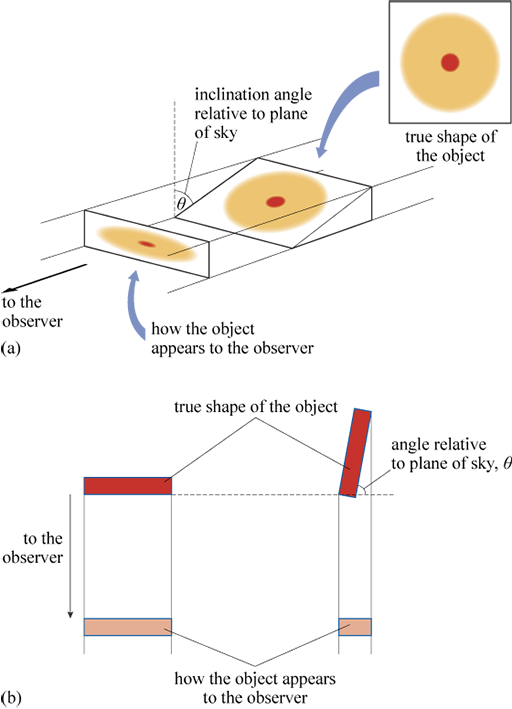1.4 Measuring shapes
As well as measuring the brightnesses and sizes of astronomical objects, images allow us to measure and interpret their shapes and structures.
Stars are simple objects that are usually close to spherical. In most cases we cannot obtain information about their shapes and structure from images (deviations from a spherical shape can sometimes be identified by other means, e.g. variability). But the shapes and structure of a diverse range of other astronomical systems – for example, star-forming regions, galaxies and their sub-components, jets of material produced by stars and black holes – can be examined using images across the electromagnetic spectrum.
Remember that our images show the distribution of light as it is recorded by our telescope detector, which is located at a particular position in space. The detector records a two-dimensional image, but the light originates from a three-dimensional object.
We are used to 2D images of 3D scenes from ordinary cameras. However, to interpret a photo of a landscape, or a group of people at a party, we have a wealth of extra information – from lighting, shadows, and our own intuition about the contents of the picture – to help our brains interpret the photo as a three-dimensional scene. Astronomical images often have fewer clues available to help us work out the underlying three-dimensional shapes, as shown in Figure 6.
Figure 6a shows an astronomical object shaped like a dinner plate (perhaps a galaxy) as viewed from three different directions. This scene depicts the effect of projection, where the object is tilting away from the plane of the sky. Note that this situation is mathematically similar to an inclined elliptical orbit.
Figure 6b shows the effect of orientation on the inferred length of a linear extended structure (perhaps an extended gas cloud or a jet-like feature).

-
At what angle relative to the plane of the sky will the linear object appear shortest in an image?
-
The greater the angle away from the plane of the sky, the shorter the structure appears when observed in an image. The object will therefore appear shortest at an angle of 90 degrees to the plane of the sky.
For a circular disc-like object, the observed major axis (i.e. twice the semimajor axis) corresponds to the true diameter of the disc, and the inclination angle (tilt, ) relative to the plane of the sky is given by
where is the measured semimajor axis and the measured semiminor axis.
If a linear object is projected at an angle of to the plane of the sky, then its true length, , is related to its measured length, , by
Example 2
You want to measure the shape of a galaxy that an image shows to have an ellipse shape, but you believe is in fact a disc (round dinner-plate shape) that is inclined relative to the observer, as in Figure 6a. The angle by which the galaxy is tilted, , is not known.
The semimajor and semiminor axes are measured from the image to be 20 arcmin and 13 arcmin, respectively. Calculate the angle of inclination, .
Solution
The longer axis tells us the true radius of the disc. The angle can then be calculated using Equation 1
-
A jet of gas is observed emerging from a young star. The length of the jet is measured to be 2.5 pc and the width is 0.3 pc. If the jet is cylindrical, and oriented at an angle of 30 degrees relative to the plane of the sky, what is its true length and ratio of its length to width (i.e. the ‘aspect ratio’)?
-
Using Equation 2, the observed length is related to the true length via . Hence the true length is
and the aspect ratio is
In other words, the object is in reality more elongated than it appears in our images.
The conclusion to draw from these calculations is that frequently in astronomy we cannot be certain of the true shape or dimensions of objects. If you had not assumed the galaxy in the example was a circular disc, you could not have obtained the inclination angle.
Sometimes the problem can be solved by using additional information, such as that obtained from the spectrum of an object. The shift of spectral lines, or their broadened widths, may be caused by the Doppler effect which can provide clues about the motion or rotation of the object concerned. If we are studying very large samples, we sometimes expect that overall the orientations are random, which enables the use of statistical methods or computer simulations to determine the overall size and shape distributions of a set of objects. However, unknown orientation angles remain a major uncertainty in many astronomical studies.
